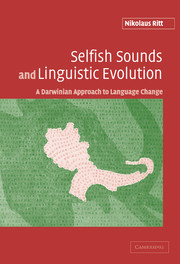Book contents
- Frontmatter
- Contents
- List of figures
- Preface
- 1 Introduction
- 2 The historical perspective
- 3 Approaching ‘language change’
- 4 The Darwinian approach
- 5 Generalising Darwinism
- 6 Towards an evolutionary theory of language
- 7 What does all this imply for the study of language change?
- 8 How to live with feet, if one happens to be a morph-meme
- 9 The prosodic evolution of English word forms or The Great Trochaic Conspiracy
- 10 Conclusion
- References
- Index
6 - Towards an evolutionary theory of language
Published online by Cambridge University Press: 22 September 2009
- Frontmatter
- Contents
- List of figures
- Preface
- 1 Introduction
- 2 The historical perspective
- 3 Approaching ‘language change’
- 4 The Darwinian approach
- 5 Generalising Darwinism
- 6 Towards an evolutionary theory of language
- 7 What does all this imply for the study of language change?
- 8 How to live with feet, if one happens to be a morph-meme
- 9 The prosodic evolution of English word forms or The Great Trochaic Conspiracy
- 10 Conclusion
- References
- Index
Summary
Can there be linguistic replicators at all?
Criteria for identifying replicators
The chances of finding an integrated evolutionary model of language and language change depend on the question of whether linguistic replicators can really be assumed to exist. Unless they do, we need not bother with the rest. Are there really any competence properties that qualify as linguistic replicators then? In order to decide, we first need clear criteria. Dawkins proposes a definition that is analogical to his definition of a ‘gene’, ‘which comes from G. C. Williams. A gene is defined as any portion of chromosomal material [i.e. DNA] that potentially lasts for enough generations to serve as a unit of natural selection. [… It] is a replicator with high copying-fidelity. Copying fidelity is another way of saying longevity-in-the-form-of-copies’ (Dawkins 1989: 28f). Accordingly, Dawkins sees a meme as ‘an entity that is capable of being transmitted from one brain to another’ (1989: 196), and Dennett basically follows him by defining memes as ‘the smallest units that replicate themselves with reliability and fecundity’.
These definitions yield the following criteria for ‘replicatorship’.
First, a replicator needs to be an ‘entity’. This means it must be identifiable, and persist for a minimal period of time with its characteristic properties intact, that is, it must have a minimal stability, or longevity.
Secondly, a replicator must be capable of being transmitted faithfully. That is to say there must be a minimal fidelity to its copies. Otherwise it would not be justified to call an entity replicating at all. So, the second criterion must be copying fidelity. Of course, while copying fidelity must be high for an entity to qualify as a replicator, it must be less than perfect for evolution to become possible.
Information
- Type
- Chapter
- Information
- Selfish Sounds and Linguistic EvolutionA Darwinian Approach to Language Change, pp. 122 - 229Publisher: Cambridge University PressPrint publication year: 2004
